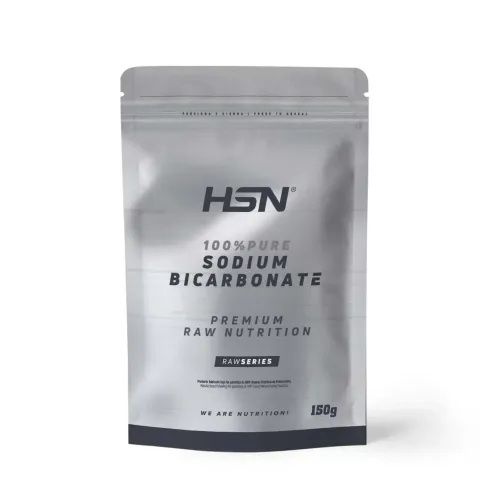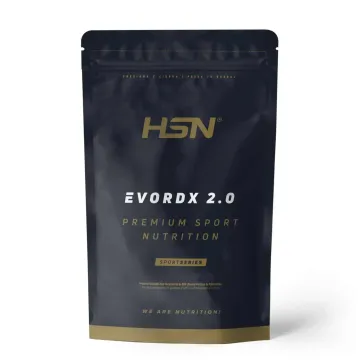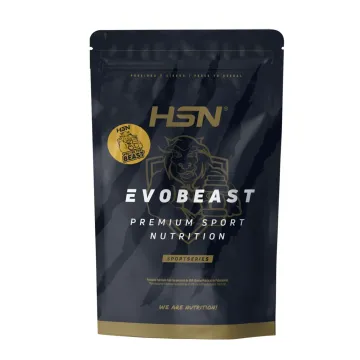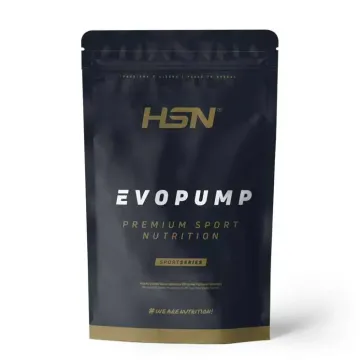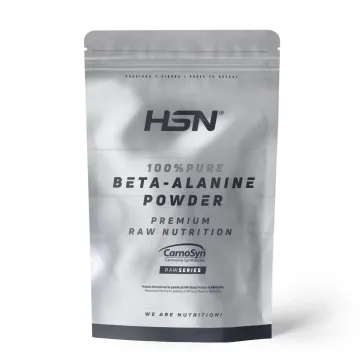- Authentic 100% pure sodium bicarbonate: no flavourings or additives of any kind.
- A compound with multiple uses: in cooking as a leavening agent and in sports contexts.
- Available in practical formats to suit your needs: 150g for occasional use, and 500g / 1kg for more frequent use.
- Reduced particle size for efficient suspension, making it easier to use.
- Suitable for all diets: vegan, non-GMO, and allergen-free.
Pure Sodium Bicarbonate - A classic buffer
Sodium Bicarbonate powder by RawSeries is a versatile food additive with many uses, from culinary applications to being employed in the sports context.
Sodium bicarbonate is considered an interesting substance due to its chemical properties. Sodium hydrogen carbonate is a sodium salt and a carbon-based compound. It has a pH (in a freshly prepared 0.1 molar aqueous solution) of 8.3 at 25°C. In a saturated solution, it has a pH between 8 and 9.
HSN’s sodium bicarbonate is pure with no added flavourings or taste maskers, and its natural taste is slightly bitter (alkaline)
Explore its uses: From the kitchen to sports
Culinary Uses of Sodium Bicarbonate
Sodium bicarbonate is a highly versatile food additive used in a wide range of kitchen applications. As an additive, its main function is to act as an alkaline agent that helps regulate acidity in food and aids in baking and cooking processes. Beyond being a key ingredient in baking, sodium bicarbonate is used to soften vegetables, improve the texture of meat, and as a cleaner for fruits and vegetables, removing residues and dirt.
In baking, sodium bicarbonate is used as a raising agent, meaning it helps dough rise, giving it a light, fluffy texture. When combined with an acid, like lemon juice or vinegar, it releases carbon dioxide (CO₂), creating air bubbles in the dough. These bubbles expand during baking, making the dough rise and become softer and airier. It’s commonly found in recipes for cookies, bread, and cakes where quick and effective leavening is required without the use of yeast.
As an anti-caking agent, sodium bicarbonate prevents powdered ingredients like salt, sugar, or spices from clumping together, especially in humid environments. Its moisture-absorbing properties help keep ingredients dry and free-flowing, improving their handling and distribution in recipes. This is particularly valuable in baking mixes, powdered seasonings, and other food products where uniform texture is essential.
Warning! Sodium bicarbonate is highly hygroscopic, meaning it absorbs moisture easily, which can cause it to clump in environments where humidity wouldn’t affect other powders like protein. Pay special attention to storage conditions, and be sure to keep it in a cool, dry place to avoid clumping.
In addition to its uses as a raising agent and anti-caking agent, sodium bicarbonate is also used as an alkalising agent in cooking. Its ability to raise the pH of foods makes it useful in preparations where reducing acidity or creating a more alkaline environment is required. For example, in making pretzels (a traditional German recipe), sodium bicarbonate is dissolved in hot water for a pre-bake bath, giving them their characteristic golden-brown colour and slightly crispy texture. It’s also used in cooking green vegetables, like spinach or broccoli, to maintain their vibrant colour by counteracting the acidity that can cause the loss of chlorophyll. In corn tortilla preparation, sodium bicarbonate can be added to soften the dough and improve its malleability.
These examples clearly show how sodium bicarbonate affects the appearance, texture, and taste of foods by altering their pH, making it useful for home cooking enthusiasts and professional chefs alike, and of course, in the general food industry.
Using Sodium Bicarbonate after meals
Sodium bicarbonate is often used after meals due to its ability to quickly and effectively neutralise stomach acid. When ingested, it reacts with hydrochloric acid in the stomach, forming sodium chloride, water, and carbon dioxide (CO₂). This reaction reduces the acidity in the stomach, making it very effective after heavy meals that cause digestive acidity. This effect has made it a popular household remedy with an almost immediate impact.
Many times, instead of pure sodium bicarbonate, you’ll find fruit salts, which are essentially the same thing—sodium bicarbonate with added flavouring to avoid its traditional bitterness. However, flavoured bicarbonate is not suitable for recipes, as no one wants pancakes tasting like fruit salt.
Additionally, sodium bicarbonate is appreciated for its fast-acting effect. Being water-soluble, it efficiently neutralises stomach acid, making it ideal for immediate relief from acidity. This simple, practical use makes it an accessible option for many people dealing with heartburn.
Sodium Bicarbonate in Sports
Sodium bicarbonate has become a popular supplement among athletes, particularly those involved in endurance sports and activities with high metabolic demands. Its use has grown due to recent studies highlighting its effectiveness in training and competitions that rely heavily on the anaerobic lactic energy system.
Sodium bicarbonate has moved from the kitchen to the pre-workout routines of athletes. Many elite and advanced amateur athletes include it as part of their supplementation strategy to maximise their performance during intense training and competitions.
In fact, internationally renowned bodies, such as the International Olympic Committee, endorse sodium bicarbonate, placing it among the group of 'Supplements with good to solid evidence of performance benefits when used in specific scenarios' (Maughan et al., 2018).
Why is sodium bicarbonate sold as a food additive?
A food additive is defined as:
'Any substance not consumed as a food itself, nor used as a characteristic ingredient of foods, but added intentionally to food for technological reasons during its manufacture, processing, preparation, treatment, packaging, transport, or storage. The purpose of additives is to improve the preservation, appearance, texture, or taste of food, and their use is regulated to ensure they are safe for human consumption.'
Sodium bicarbonate is used as a food additive, which categorises it as such, but this doesn’t limit its use as a dietary supplement, especially since athletes and sportspeople of various levels have incorporated it into their nutrition for performance-enhancing purposes.
How much bicarbonate to use for each purpose
Sodium bicarbonate has multiple uses thanks to its versatile properties, and its application varies depending on the context:
As an additive:
- Raising agent: In baking, use about 1/2 - 1 teaspoon of sodium bicarbonate for every 500 grams of flour. Mix it with dry ingredients and, when combined with an acid (like lemon juice, yoghurt, or vinegar), it releases carbon dioxide, making the dough rise.
- Alkalising agent: In recipes that require pH adjustment, add a small amount (usually a pinch or up to 1/4 teaspoon) directly to the mixture until the desired pH is reached.
- Anti-caking agent: In powdered products, use minimal amounts, generally less than 2% of the total weight, to prevent clumping and maintain product consistency.
After meals:
It is recommended to dissolve about 5g of sodium bicarbonate in a glass (200-250ml) of water or another non-acidic beverage. Drink after meals or when experiencing heartburn.
As a sports supplement:
The most commonly recommended dose is 0.2 to 0.3 grams of sodium bicarbonate per kilogram of body weight, dissolved in approximately 250ml of water.
It should be taken 60 to 90 minutes before competition or training to allow the body to absorb the bicarbonate and reach its peak during the activity.
Remember that it is advisable to test its use during training before a competition, as the high dose can cause gastrointestinal discomfort in some people. Additionally, staying well hydrated is important when taking bicarbonate at these doses.
Bicarbonate – Is it normal for it to foam?
Sodium bicarbonate, when mixed with water alone, doesn’t release gas, but due to its properties, it does produce large amounts of CO₂, seen as “bubbles” or “foam”, when mixed with an acid.
This includes acids like citric acid, which is often found in many pre-workout formulas and even flavoured protein powders. We recommend avoiding mixing bicarbonate with these products, or with acidic juices like orange juice, in a shaker and shaking it.
If you mix bicarbonate with an acidic nutrient, do it in a glass and stir with a spoon, as it will integrate smoothly and you’ll have better control over the foam release.
Can I mix bicarbonate with pre-workouts?
As mentioned earlier, yes, no problem.
The fact that sodium bicarbonate produces carbon dioxide through effervescence as a chemical reaction when it comes into contact with an acid doesn’t mean it loses its properties, becomes less safe, or causes any negative effects. Therefore, mixing sodium bicarbonate with pre-workout formulas containing reactive substances, such as citrulline malate, is not an issue and is completely compatible.
In fact, this is a common practice among people who use sodium bicarbonate before training sessions and competitions.
What Does Sodium Bicarbonate Taste Like?
Sodium bicarbonate has an intensely salty taste, with acidic and bitter undertones, characteristic of the compound itself:

Scientific references
- Racinais, S., Hosokawa, Y., Akama, T., Bermon, S., Bigard, X., Casa, D. J., … Budgett, R. (2022). IOC consensus statement on recommendations and regulations for sport events in the heat. British Journal of Sports Medicine, 57(1), 8–25.
- Lancha Junior, A. H., de Salles Painelli, V., Saunders, B., & Artioli, G. G. (2015). Nutritional Strategies to Modulate Intracellular and Extracellular Buffering Capacity During High-Intensity Exercise. Sports Medicine, 45, 71–81.
- Lino, R. S., Lagares, L. S., Oliveira, C. V. C., Queiroz, C. O., Pinto, L. L. T., Almeida, L. A. B., … dos Santos, C. P. C. (2021). Effect of sodium bicarbonate supplementation on two different performance indicators in sports: a systematic review with meta-analysis. Physical Activity and Nutrition, 25(1), 7–15.
- Grgic, J., Pedisic, Z., Saunders, B., Artioli, G. G., Schoenfeld, B. J., McKenna, M. J., … Campbell, B. I. (2021). International Society of Sports Nutrition position stand: sodium bicarbonate and exercise performance. Journal of the International Society of Sports Nutrition, 18(1), 61.
- Grgic, J., Grgic, I., Del Coso, J., Schoenfeld, B. J., & Pedisic, Z. (2021). Effects of sodium bicarbonate supplementation on exercise performance: an umbrella review. Journal of the International Society of Sports Nutrition, 18(1), 71.
 Before
Before After
After During
During Morning
Morning Afternoon
Afternoon Night
Night Before
Before After
After During
During Morning
Morning Afternoon
Afternoon Night
Night Before
Before After
After During
During Morning
Morning Afternoon
Afternoon Night
Night







